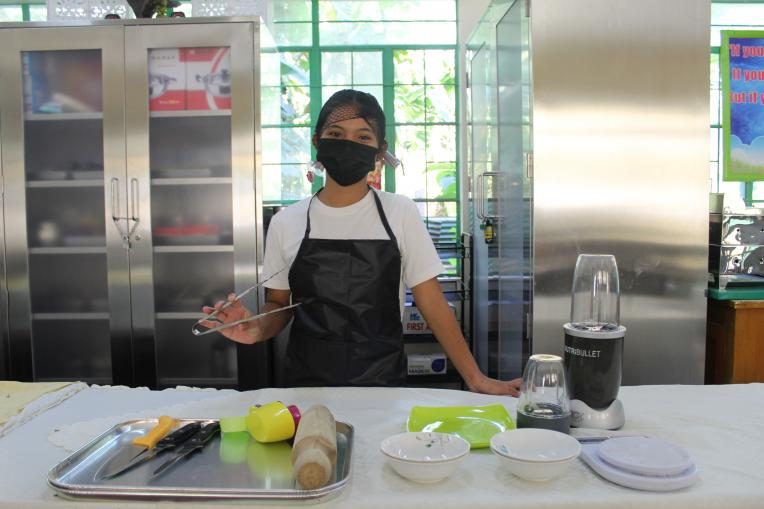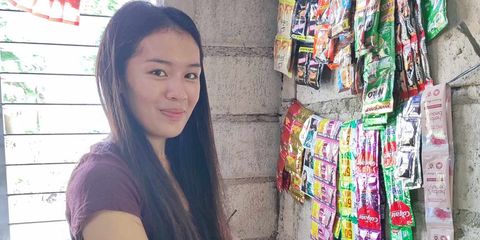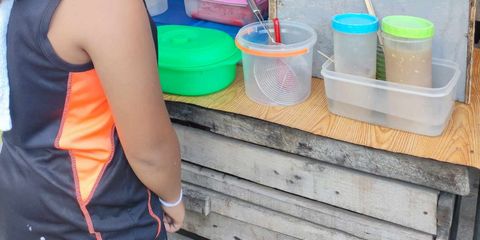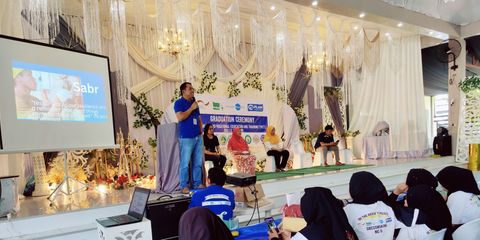15 OCTOBER 2021
Marialyn, 16, was at risk of dropping out of school. Now she is staying in school, learning new skills and looking to a positive future.

Marialyn, a 10th grader, has always wanted to be a chef and at only 16, she’s on her way to becoming one.
Her journey all started with cassava leaves. When Marialyn was in 9th grade, she learned the fundamentals of scientific research. This class taught students like her to become critical thinkers and problem solvers.
“I became more aware of my surroundings and I developed an interest in looking for ways to solve my community’s everyday problems,” shared Marialyn.
A month later, Marialyn experienced her big ‘aha’ moment—she came up with a research idea which would double as a potential business venture.
She then spent a year in her school’s technical-vocational-livelihood (TVL) laboratory to perfect her latest concoction with the help of her TVL teachers.
Learning new skills
“One day, I was observing my auntie cooking some cassava leaves,” says Marialyn. “I never thought that they could be cooked. After that, I researched all about cassava leaves and found that it’s actually edible.”
Cassava is among the Philippines’ major root crops. Each year, Filipino farmers plant cassava over thousands of hectares of agricultural land across the country. Cassava is commonly processed as chips and starch, either as food products or as animal feed.
Don’t give up and do all you can till you achieve your goal.
In the Philippines, the highest production of cassava comes from Northern Mindanao. However, it’s also available in other regions including Marialyn’s hometown, Western Samar.
“People need to keep in mind that eating cassava has a lot of risks,” warns Marialyn. “In older times, the only cassava part which can be utilised is its roots. The cassava leaves are often disregarded, that’s why I researched what can be done to also utilise it.”
Generating an income
Marialyn explained that the process of cooking cassava leaves is relatively easy. “You can also make a good income from it,” she added. “And you only need to shell out a small amount of money, yet the returns are pretty high.”
“From a small capital of 200 pesos (€3.50), 250 to 300 packs of cassava leaves crackers can be made,” said Marialyn. “Each of these packs may be sold for 5 pesos each.
“By blending cassava leaves with pickle relish, onion, and flour, you can produce chips,” Marialyn explained. “Then you knead the dough, shape, then fry. Cassava leaves contain nutritious compounds like ascorbic acid and vitamin A,” Marialyn continued. “They also have a significant amount of riboflavin. All these are very good for our health.”
Plan International’s RAISE Above project provided Marialyn’s school with the proper ingredients and equipment. These resources were directed to the school’s Drop-Out Reduction Programme, which supported Marialyn’s research project.
The resulting income-generating project provides financial assistance among learners who are at risk of dropping out. The project also promotes camaraderie among teachers, students, and communities.
After their school’s Science Fair, Marialyn’s teacher helped her submit her research project to the Department of Education’s Catbalogan City Division. Only the most innovative school research projects are given this opportunity.
Self-esteem boosted
Aside from receiving accolades from school and starting her small business selling cassava chips, Marialyn shared how this research venture also boosted her self-confidence. “I think my self-esteem improved a lot,” she said. “I also continue to connect with other students through this research.”
Marialyn advises her fellow students to also explore and experiment with ideas, “Don’t give up and do all you can till you achieve your goal.”
Marialyn proves that creativity, curiosity, and resourcefulness can really go a long way. After all, there’s no idea ever too small or too big. “You need to be diligent even when it gets difficult,” she added. “You should be confident when you’re doing your research.”
With the help of her school, Marialyn’s research project reached the Department of Trade and Industry, as well as the Department of Science and Technology. These government agencies helped Marialyn explore her options for marketing and packaging. Marialyn hopes more schools can support their students’ research interests and entrepreneurial inclinations.
The RAISE Above Project empowers adolescent girls, young women, and young men by supporting their rights to education and skills development.
It is implemented by Plan International Philippines through the support and funding of Dubai Cares, which is part of the Mohammed bin Rashid Al Maktoum Global Initiatives.
Categories: Education, Skills and work


